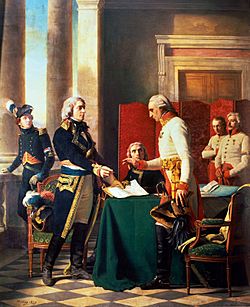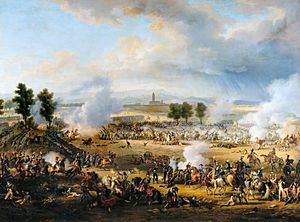Convention of Alessandria facts for kids

Signing of the Convention of Alexandria (by Michel Martin Drolling)
|
|
| Context | after the defeat of the Archduchy of Austria by the French First Republic in the War of the Second Coalition |
|---|---|
| Signed | 15 June 1800 |
| Location | Alessandria |
| Parties | |
The Convention of Alessandria was an agreement signed on June 15, 1800. It was also called the Armistice of Marengo. This agreement was made between France, led by Napoleon, and Austria. It happened during a big conflict known as the War of the Second Coalition.
After France won the Battle of Marengo, Austria agreed to leave parts of Italy. They had to give up important areas like Piedmont and Milan. Britain and Austria were allies and hoped to make a peace deal with France. But Napoleon wanted separate agreements with each country. The talks failed, and fighting started again on November 22, 1800.
Contents
What Led to the Convention?
The War of the Second Coalition was the second major war against France. Many European kingdoms fought against France. The main countries in this group were Britain, Austria, and Russia. Their goal was to stop France from expanding. They also wanted to bring back the old royal family in France.
French troops went back to Italy in 1799. This was after their earlier control there had ended. Napoleon Bonaparte took power in France in November 1799. In May 1800, he led his army across the Alps mountains. This surprise move threatened the Austrian army's supply lines in northern Italy.
The French army then captured Milan on June 2. They also took Pavia, Piacenza, and Stradella. This cut off Austria's main supply route. Napoleon hoped the Austrians would be busy with the Siege of Genoa. But the French general André Masséna surrendered Genoa on June 4. This freed many Austrian soldiers to fight Napoleon.
On June 9, French General Jean Lannes defeated Austrian General Peter Ott. Napoleon then thought the Austrians would not attack and would retreat. The Battle of Marengo happened on June 14, 1800. It was fought near Alessandria between Napoleon and Austrian General Michael von Melas. By the end of the day, the French had won a surprising victory.
The Agreement of Alessandria
Early on June 15, 1800, General von Melas sent officers to the French camp. They carried a flag of surrender. Napoleon was surprised but quickly accepted. A cease-fire was signed just a few hours later. In this first agreement, the Austrians had to move back behind the Bormida river. Fighting would stop for 48 hours.
The Austrians first hoped to give up only Piedmont and Genoa. But Napoleon demanded they retreat even further. He wanted them to go behind the Po and Mincio rivers. The final agreement was officially signed as the Convention of Alessandria.
The convention was signed on June 15. It ended the fighting for a while. Austria agreed to leave Italy as far as the Mincio river. They also gave up all their strongholds in Piedmont and Milan. This meant they lost everything they had gained in 1798 and 1799.
The Austrians agreed to give France several cities by June 20. These included Tortona, Alessandria, Milan, Turin, Pizzighetone, Arona, and Piacenza. By June 24, they had to surrender the fortress of Coni, the castles of Seva and Savona, and the city of Genoa. The city of Urbino was to be given up by June 26.
Land between the Chiesa, Oglio, and Po rivers went to France. The area between the Chiesa and the Mincio was made a neutral zone. This meant neither army could occupy it. Austria kept control of Tuscany. Most of their army was allowed to retreat.
What Happened Next?
On June 17, Napoleon left for Paris after the agreement was signed. He stopped in Milan that day and was welcomed as a hero. Large crowds celebrated his arrival. The Cisalpine Republic was set up again as a French-controlled state. A temporary government was put in place. This would last until a peace treaty was signed with Austria.
Many strongholds listed in the agreement were given up by the Austrians. The French then destroyed their defenses. This included Genoa on June 24. Napoleon left Milan that same day. He stopped briefly in Turin and Lyon before reaching Paris on July 2. This victory made Napoleon's power stronger in Paris. He was the First Consul of France. One historian said the battle was like a "true coronation" for Napoleon's power.
An Austrian general, Count Joseph Saint-Julien, took the agreement to Emperor Francis II. The Austrian government soon approved it. However, it turned out to be only a temporary stop in fighting. The Austrian government refused to accept the terms. They did not want to give up their Italian lands.
Just hours before receiving the agreement on June 20, 1800, Francis II had signed a treaty with Britain. In this treaty, Britain agreed to give Austria two million pounds. This was in exchange for Austria continuing the war with France. The treaty also said Austria could not talk peace with France without Britain until February 1, 1801.
Austria then sent Saint-Julien to Paris. He was to deliver news of the treaty's approval. He also was to discuss the terms further. He arrived on July 21 and began talks. On July 22, he attended a meeting. There, Saint-Julien was convinced to act as an official diplomat. He signed some early agreements on July 28.
Saint-Julien and another French officer, Géraud Duroc, were sent to deliver the news to Vienna. They arrived on August 4. But Austria refused the agreements because of their treaty with Britain. Duroc was sent away, and Saint-Julien was arrested. He was accused of negotiating without proper orders.
On September 29, the Convention of Castiglione was signed. This extended the Alessandria agreement. But further talks in Lunéville did not work. Napoleon still wanted separate peace treaties with Britain and Austria. So, on November 22, 1800, fighting began again.
What Historians Think
Many historians have looked back at the Convention of Alessandria. British historian John Mitchell said in 1846 that France would have accepted less. He wrote that "nothing equal to this ill-fated convention had ever been known in military history." Another British historian, Thomas Henry Dyer, called it "one of the most disgraceful capitulations in history" in 1877.
Historian David Bell noted in 2014 that most of the Austrian army survived the Battle of Marengo. He believed General Melas could have kept fighting. A Prussian historian, Dietrich Heinrich von Bülow, said: "Bonaparte did not seize success; Melas threw it away." Historian David Hollins said the victory helped Napoleon "secure his political power for the next 14 years."




